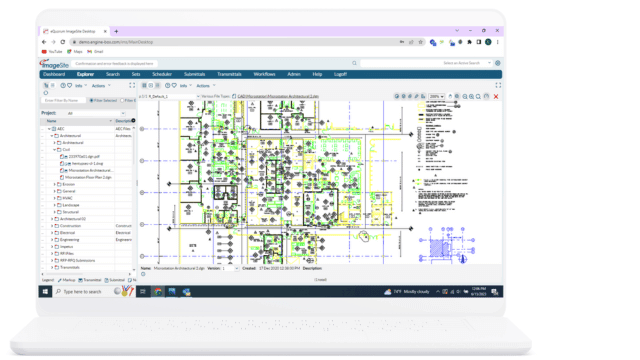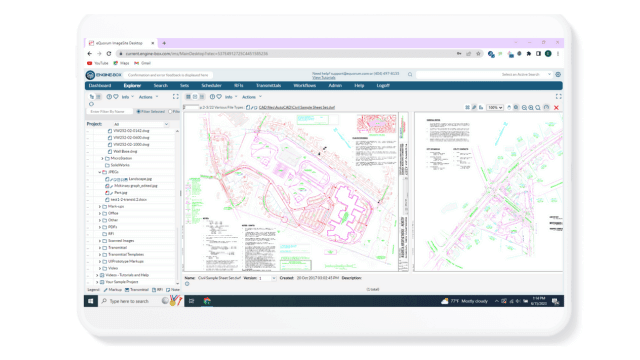Cloud Computing: Exploring The Possibilities
Cloud Computing: Exploring The Possibilities
Over the last decade, Cloud Computing has gained remarkable traction, as more and more organizations seek to distribute their company’s files remotely. Cloud Computing has been around for quite some time, but increases in telecommuting, globalization, and Internet connection speeds have stimulated the industry's growth. Still, there is a lot of mystery behind Cloud Computing, as organizations begin their endeavor to explore the possibilities of “The Cloud.”
What is Cloud Computing?
Cloud Computing provides companies with access to computer system resources, without direct active management by the users. There are many benefits to Cloud Computing, from cost savings to flexibility and security, all of which can be realized by organizations looking to improve the way they manage their data, drawings, or documents.
Cloud software comes in many shapes and sizes and can be used for various applications. Common applications include Cloud CRM (Customer Relationship Management) platforms and Cloud EDMS (Electronic Document Management Software). Both systems can be accessed by workers across the globe, promoting cross-functional collaboration and providing a scalable solution for small to medium-sized businesses (SMBs) and large enterprises alike.
What Is Cloud Document Management and Why You Need It
2.21 mins
With cloud computing, companies have access to their files from more locations than ever before. Companies can expect significant cost savings and rapid ROI when using cloud systems, as they don’t require organizations to manage their own IT infrastructure.
54% of organizations worldwide are motivated to use Software-as-a-Service (SaaS) solutions to increase productivity; 35% of organizations use SaaS solutions to reduce costs; 27% to increase security; and 23% to improve the employee experience.
Source: BetterCloud, 2020
Cloud Computing in Engineering
Cloud Computing has made a notable impact in the engineering Industries. Increases in efficiency and productivity have paved the way for rapid expansion in the AEC (Architecture, Engineering, and Construction), Manufacturing, and Utility industries. Engineers rely on the Cloud to share files and documents across departments while maintaining a high level of security.
Engineers often use a Cloud document management system to manage the high volume of drawings and documents required in engineering workflows. While on-premise systems often provide similar features, Cloud systems offer the flexibility engineers need to collaborate on-site, on the production floor, or in the office without needing to set up VPNs or getting special access to their corporate network.
Cloud Syncing and Sharing
Cloud syncing and sharing can promote project collaboration across different departments and locations by allowing users to access files simultaneously with the assurance that all parties are viewing the most current files and documents - a feature included in Version Control.
It also allows system administrators to establish an archive or disaster recovery site that is automatically synced, or synced when needed. Syncing can be performed continuously or during scheduled times and can even be performed on-demand.
Cloud Computing and Globalization
Globalization has played a significant role in the growth of the Cloud Computing industry, as the Cloud enables employees to access company files remotely from anywhere on the globe. More and more, organizations are using Cloud applications to support their business, seeing the benefits of Cloud systems significantly outweighing the costs.
Across the African continent, improvements to the telecommunication infrastructure are facilitating the demand for Cloud Computing. In the coming years, we can expect to see Cloud Computing impact the African business landscape by improving operational performance and providing organizations with a powerful platform for growth. The same can be seen in Europe, Asia, and North America.
Cloud Computing is fundamental for a competitive single market for data and services, as it promotes an innovative economy. According to the European Union, the global data volume is growing very fast, and Cloud Computing provides companies with the necessary means to manage their data.
According to many studies, investments in SaaS-based (Software-as-a-Service) platforms outperform on-premise platforms in most scenarios. The ROI of SaaS-based systems is typically positive within the first year, while on-premise systems can take much longer to achieve the same result, with companies being responsible for ongoing costs of maintaining their own IT infrastructure. With that being said, these systems do allow companies to maintain complete control over their data, and on-premise systems are typically recommended for industries such as government and banking, where they operate under strict regulatory control.
41% of organizations currently using Cloud databases have realized improved speed-to-market. In addition, 31% realized improved security, 28% noted improved efficiency, and 30% enjoyed the ease of access.
Source: DZone, 2020
Cloud Document Management System Security
Many organizations have expressed concerns regarding the security of Cloud-based applications. In reality, however, there is little for them to worry about. EngineBox uses industry-leading security and backup provided by AWS (Amazon Web Services). Infrastructure security is typically improved as the system is hosted on a Tier 1 outsourced platform provider. Virus and malware protection is included with commercial-grade intrusion prevention.
Access control is determined by the designated system administrator, which allows them to restrict file access to users either at the global, group, project, file, user or file metadata level, to ensure files are only accessible to those who need them for their specific job function. Additionally, EngineBox encrypts all communications to secure file image sharing and downloads performed by permitted users.
AWS Marketplace
AWS Marketplace is Amazon Web Services’ leading Cloud, SaaS Solutions Marketplace. It features a wide selection of commercial and free IT and business software, including software infrastructures such as databases and application servers, IoT solutions, developer tools, and business applications.
AWS Marketplace makes it easier than ever before to deploy software such as EngineBox, eQuorum’s leading cloud workflow and engineering document management software. Click here to learn more about EngineBox on AWS Marketplace, or schedule your free trial here.
Summary
Cloud computing enables organizations to explore new possibilities regarding remote collaboration, file security, and efficiency. It provides SMBs with unlimited scalability and provides large enterprises with new capabilities in terms of globalization and the speed at which they communicate with remote workers. Cloud workflow and document management platforms can further improve a company’s work quality by providing them with the collaboration workspaces they need to manage their files and documents reliably and efficiently.
Cloud DMS Features
Our EDMS solutions
ImageSite and EngineBox are eQuorum’s robust workflow and document management solutions, created to help workers manage their essential workflows while maintaining complete control over their engineering files and documents. Not only do they provide a secure collaboration site for workers, but they also help organizations manage document distribution with third parties like vendors, contractors, and customers. Both systems are offered at a competitive price, enabling organizations to get a quick return on their investment by providing the features and functionality needed to help organizations improve efficiency, productivity, and collaboration. Companies can choose from concurrent user subscriptions or named user subscriptions, ensuring organizations have subscription options that make sense for their business.

ImageSite®
Our single source engineering workflow and document management system. Built in HTML5 so there is no software to deploy to client computers or mobile apps to download. Offered as an On-premise or Private Cloud system.
EngineBox™
EngineBox is a cloud based workflow and document management version of ImageSite that resides outside the corporate network.
Our EDMS solutions
ImageSite and EngineBox are eQuorum’s robust workflow and document management solutions, created to help workers manage their essential workflows while maintaining complete control over their engineering files and documents. Not only do they provide a secure collaboration site for workers, but they also help organizations manage document distribution with third parties like vendors, contractors, and customers. Both systems are offered at a competitive price, enabling organizations to get a quick return on their investment by providing the features and functionality needed to help organizations improve efficiency, productivity, and collaboration. Companies can choose from concurrent user subscriptions or named user subscriptions, ensuring organizations have subscription options that make sense for their business.

EngineBox™
EngineBox is a cloud based workflow and document management version of ImageSite that resides outside the corporate network.
The eQuorum Customer Promise
In 2005, eQuorum developed the first all browser-based EDMS. The system, although for on-premise use, was still created to remove client software and JAVA from user computers and allow users to have a single viewer based on the simple navigation functionality of browsers. Today, eQuorum provides that same application in a private Cloud or a SaaS Cloud option. We can do this because we are, and have always been, browser-based, understanding the enhanced speed, security, and usability of this technology.
With the abundance of document management systems on the market today, there’s no doubt that choosing the right Cloud document management software can be a difficult decision. eQuorum is here to provide a comprehensive, powerful, and most importantly – affordable Cloud document management solution. We believe in providing real value to our customers by eliminating unnecessary costs, providing industry-leading functionality, and equipping your team with the right tools using cutting edge technology to bring your products to market faster.
eQuorum®
We specialize in engineering workflow and document management. Our comprehensive, yet easy-to-use software provides the solution to manage data from design to manufacturing and production, to sales, support and administration.
